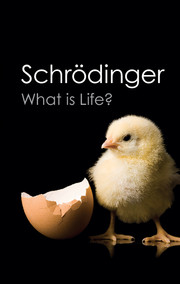Book contents
- Frontmatter
- Contents
- WHAT IS LIFE?
- Foreword
- Preface
- 1 THE CLASSICAL PHYSICIST'S APPROACH TO THE SUBJECT
- 2 THE HEREDITARY MECHANISM
- 3 MUTATIONS
- 4 THE QUANTUM-MECHANICAL EVIDENCE
- 5 DELBRÜCK'S MODEL DISCUSSED AND TESTED
- 6 ORDER, DISORDER AND ENTROPY
- 7 IS LIFE BASED ON THE LAWS OF PHYSICS?
- EPILOGUE ON DETERMINISM AND FREE WILL
- MIND AND MATTER
- Autobiographical Sketches
2 - THE HEREDITARY MECHANISM
Published online by Cambridge University Press: 05 September 2014
- Frontmatter
- Contents
- WHAT IS LIFE?
- Foreword
- Preface
- 1 THE CLASSICAL PHYSICIST'S APPROACH TO THE SUBJECT
- 2 THE HEREDITARY MECHANISM
- 3 MUTATIONS
- 4 THE QUANTUM-MECHANICAL EVIDENCE
- 5 DELBRÜCK'S MODEL DISCUSSED AND TESTED
- 6 ORDER, DISORDER AND ENTROPY
- 7 IS LIFE BASED ON THE LAWS OF PHYSICS?
- EPILOGUE ON DETERMINISM AND FREE WILL
- MIND AND MATTER
- Autobiographical Sketches
Summary
Das Sein ist ewig; dernn Gesetze
Bewahren die lebend'gen Schätze,
Aus welchen sich das All geschmückt.
goetheTHE CLASSICAL PHYSICIST'S EXPECTATION, FAR FROM BEING TRIVIAL, IS WRONG
Thus we have come to the conclusion that an organism and all the biologically relevant processes that it experiences must have an extremely ‘many-atomic’ structure and must be safeguarded against haphazard, ‘single-atomic’ events attaining too great importance. That, the ‘naïve physicist’ tells us, is essential, so that the organism may, so to speak, have sufficiently accurate physical laws on which to draw for setting up its marvellously regular and well-ordered working. How do these conclusions, reached, biologically speaking, a priori (that is, from the purely physical point of view), fit in with actual biological facts?
At first sight one is inclined to think that the conclusions are little more than trivial. A biologist of, say, thirty years ago might have said that, although it was quite suitable for a popular lecturer to emphasize the importance, in the organism as elsewhere, of statistical physics, the point was, in fact, rather a familiar truism. For, naturally, not only the body of an adult individual of any higher species, but every single cell composing it contains a ‘cosmical’ number of single atoms of every kind.
- Type
- Chapter
- Information
- What is Life?With Mind and Matter and Autobiographical Sketches, pp. 19 - 31Publisher: Cambridge University PressPrint publication year: 2012



